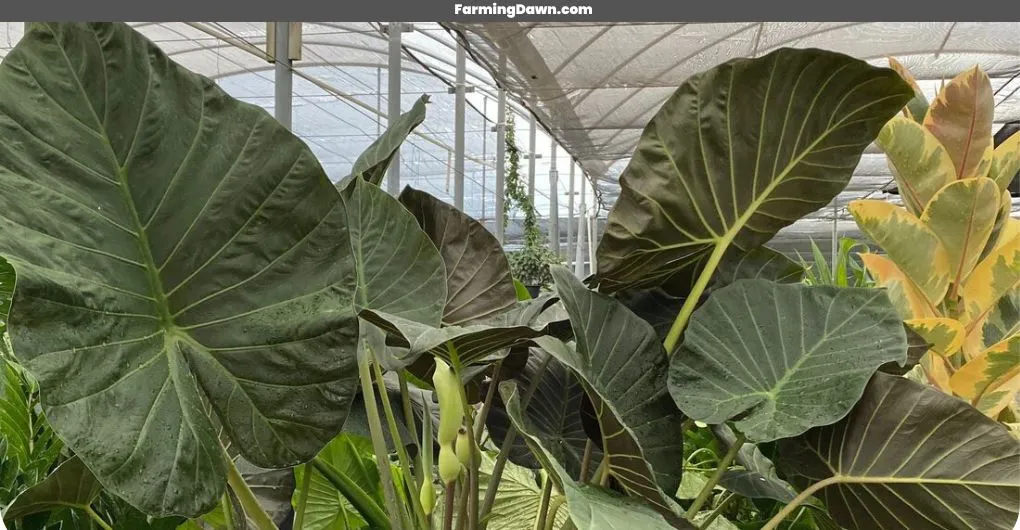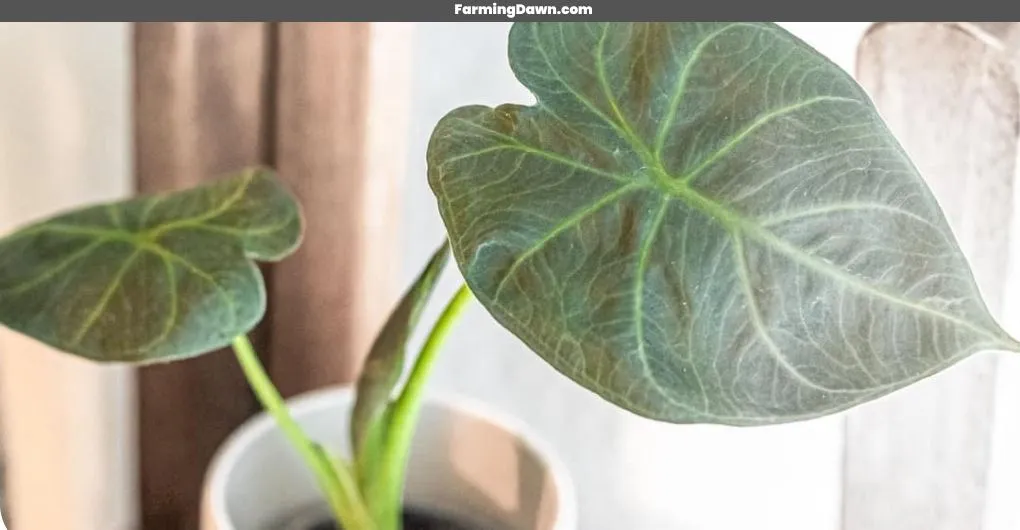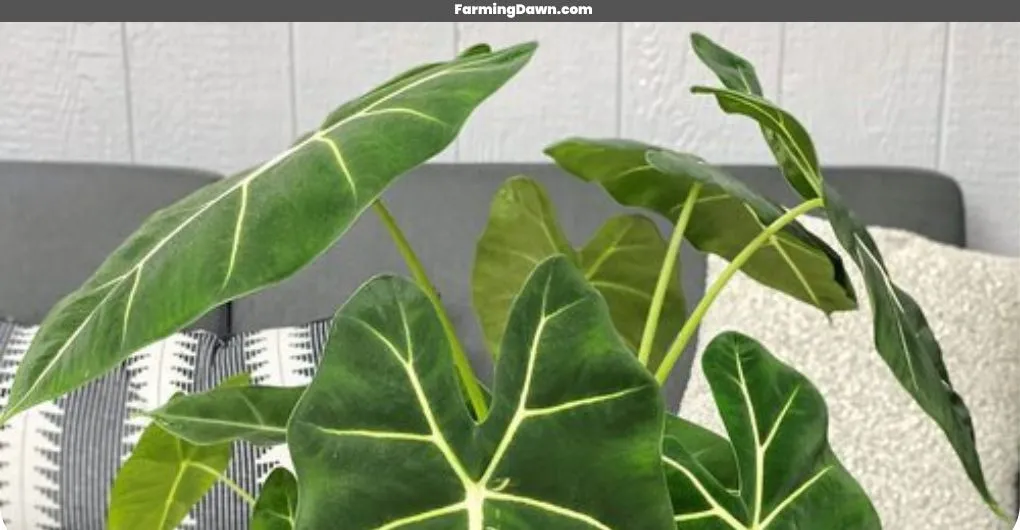In this post, we’re gonna talk about the Alocasia Regal Shield Plant, one of nature’s most stunning creations. This unique beauty is sure to make you feel like part of something special, an exclusive club that knows how to appreciate nature in its fullest form.
Let me tell you all about it; from where it originates, its characteristics, care requirements, growth pattern, and propagation methods. So come along with me as I take you on a journey through this amazing plant!
Introduction To The Alocasia Regal Shield Plant
Alocasia Regal Shield Plant is a beauty, and with its unique characteristics, it’ll be sure to make an interesting addition to your home or garden. This regal shield plant originates from India and Southeast Asia, which means that when you look at it in your own space, you can really feel a connection to those cultures.
When cared for properly, this regal shield will grow anywhere between 2-6 feet tall, but don’t worry if you’re not too confident about taking care of it as they do require some special attention! So if you think this regal shield plant could bring something beautiful into your life then why not give it a go?
See more: the overview and growth of Anthurium Warocqueanum.
| Name | Common Name: Elephant Ear
Scientific Name: Alocasia Regal Shield |
| Botanical Name | Alocasia odora×Alocasia reginula |
| Family | Araceae |
| Plant Type | Broad-leafed flowering perennial |
| Plant Size | 2-6 ft. tall (indoors), 4-6 ft. tall (outdoors) |
| Sunlight tolerance | Full, Partial |
| Soil Type | prefers light, loamy, well-drained soil |
| Soil pH | between 5.5 and 7 |
| Bloom Time | Spring, Summer (January-February) (November- December) |
| Flower Color | White, Green, pale-colored spathes |
| Hardiness Zones | 9-11, USA |
| Native Area | Native to the subtropics of Asia and Australia |
| Toxicity | Toxic to animals(pets) and people. |
Origin And Characteristics Of Alocasia Regal Shield
Mysteriously unique, the Alocasia Regal Shield is a captivating plant with an intriguing origin and characteristics. This regal shield hails from Southeast Asia and is native to the subtropics of Asia and Australia where its popularity has steadily grown over time.
It’s renowned for its striking foliage of shiny green leaves that are arranged in a rosette pattern and adorned with white veins running through them. What sets it apart from other plants is its bold stems that come in shades of purple or dark red depending on the variety.
The Regal Shield also loves warm temperatures between 60°F to 75°F making it ideal for indoor environments! As if these features weren’t enough, this majestic plant offers an array of benefits such as air purification and being pest-resistant, truly making it a royal addition to any home or office space.
Learn more: The characteristics of Philodendron verrucosum.
So don your own regal crown and bring some royalty to your space with the Regal Shield!

How To Care For Alocasia Regal Shield?
To properly care for the regal shield, you need to take care of the following factors:
- Soil Requirements
- Watering
- Fertilizing
- Pruning And Pest Control
- Repotting
See more: How to care for Silver Sword Philodendron Plant.
Soil Requirements
To ensure your Alocasia Regal Shields will grow strong and healthy indoors, you must pay attention to your soil requirements. A well-draining potting mix made up of equal parts peat moss, perlite or vermiculite, and compost works best for these plants.
On top of that, adding some slow-release fertilizer at the time of planting can help give your regal shields a nice boost. With proper care and maintenance, your regal shield plants should thrive for many years ahead!
Watering
When it comes to watering your Alocasia Regal Shield Plant, less is more. I always start by feeling the soil and seeing if it’s dry before giving my plant any water. If the soil feels damp or wet then you should wait until it starts to feel dry again.
Overwatering is one of the biggest killers of this beautiful houseplant so make sure you don’t overwater! When you do decide to water your plant, give it a good soak with lukewarm water as this will help promote healthy growth and prevent root rot.
Just remember that too much water can be damaging so don’t overdo it, if in doubt, on the side of caution and wait a few days before watering again.
Fertilizing
Now that we’ve talked about watering your Alocasia Regal Shield plant, let’s move on to fertilizing. Fertilizing is an important step in keeping this variegated regal shield healthy and happy! I recommend using a balanced 10-10-10 fertilizer every two months while the plant is actively growing.
Pay attention to the directions on the package so you don’t over or under-fertilize your regal alocasia. Also, be sure to water thoroughly before applying any fertilizer; it’s best if the soil is already damp prior to application. Your Alocasia will thank you for giving it all the nutrients it needs to grow strong and vibrant!
Pruning And Pest Control
When it comes to pruning and pest control for your Alocasia Regal Shield, you may be wondering if the size of this regal elephant ear is too large to manage. But with a little bit of effort, and a few helpful hints, you can keep your plant looking beautiful year-round!
Pruning will help maintain its impressive size while keeping an eye out for pests like mealybugs or spider mites that could harm the health of your beloved houseplant. To start off, inspect each part of the alocasia’s leaves carefully and remove any dead foliage.
If there’s something suspicious lurking near the base, use tweezers or rubbing alcohol on a cotton swab to get rid of unwanted critters quickly without damaging the plant further. Next, trim away any long stems so that they don’t become overgrown as well as any discolored leaves for extra tidiness.
Make sure to give your Regal Shield plenty of water and light, these are key factors in ensuring its healthy growth.
Repotting
When it comes to repotting your Alocasia regal shield, you’ll want to take special care. It needs a bit of extra effort and attention to get the job done right. But don’t worry, with a few simple steps, you can have your plant back in its new home in no time! Here’s what you need to do:
First, choose a pot that is slightly larger than the current one, this will give your plant plenty of room to grow.
Make sure the container has good drainage holes so excess water can escape.
Fill the bottom of the pot with some high-quality soil mix suitable for tropical plants such as alocasia species.
Take out the plant from its old pot carefully and loosen any roots that are growing around or through them. Then put it into the new pot and fill up around it with more soil until it’s firmly held in place.
Water generously once it’s planted and make sure that there is adequate humidity by misting regularly or placing it near a humidifier.
Repotting a regal shield may seem daunting at first but if done properly, it will ensure your beloved plant stays healthy for many years to come!
How To Grow Alocasia Regal Shield?
I love growing regal shield because it has such an exotic look. To keep it looking its best, I make sure to water it regularly, but not too much. I also feed it with a liquid fertilizer every couple of weeks which really makes a difference.

Recommended Growing Conditions
I’m sure you’re excited to get your new Alocasia regal shield plant and want to make sure it’s taken care of properly. To keep this beautiful plant thriving, there are some recommended growing conditions that should be followed.
First off, the Regal Shield Plant prefers a warm environment with temperatures between 18°C – 29°C (65°F – 85°F). It thrives in medium light or bright indirect sunlight but needs protection from direct sun which can burn its leaves and cause them to yellow.
When watering, ensure the soil is evenly moistened; over-watering will lead to root rot so use caution. Lastly, fertilize during the summer months for best results. So if you follow these steps, you’ll have an amazing-looking regal shield on display!
Watering
Taking care of your Regal Shield means knowing when and how much to water it. It’s important not to over-water, as this can cause root rot, but also make sure the soil is moist at all times. I’d suggest checking on the plant every few days, stick your finger in the top inch or so of soil and if it feels dry, give it a good drink.
Over-watering can be just as dangerous for these plants as under-watering them! Give the potting mix time to drain between waterings and don’t leave standing water in their trays or saucers.
Feeding
Now that we’ve discussed watering your Alocasia Regal Shield, let’s talk about feeding it too. It loves a balanced fertilizer every two weeks during its growing season – spring to late summer. Don’t forget to feed the variegated regal shield either!
A half-strength liquid fertilizer works best and should be applied directly to the soil rather than on the leaves. Your beautiful plant will thrive with regular feeds as well as proper care and attention – it’ll reward you by producing lush green foliage with stunningly bright veins of white or silver!
How To Propagate Alocasia Regal Shield?
One of the best methods to propagate regal shield plants is seed propagation, which is great for gardeners who want to save money. Rhizome division is another good option if you have a larger mother plant. And, stem cuttings are a great way to clone a mature plant and expand your collection.
I’m sure there are lots of other propagation techniques out there, but these are three of my favorites. Let’s dig in and talk about all the details!
Learn more: How to propagate string of turtles?

Seed Propagation
As for propagating this plant from seed, it can be quite challenging since the seeds need consistently moist soil to germinate properly. You’ll also want to make sure you’re planting at the right time of year, late spring is usually best if you live in an area with seasonal changes.
Other than that, just give your new plants ample light and water and they should grow strong! With patience and care, soon enough your Regal Shield will be thriving like never before.
Rhizome Division
Now, let’s move on to the rhizome division for propagating your regal shield alocasia care. This technique is great if you’re looking to quickly increase the number of plants in your collection, but it does require some patience and precision.
Start by carefully removing any dead or damaged parts from the rhizomes before cutting them into two or more sections with a sharp knife. Make sure each section has at least one healthy bud so that it can grow new leaves when replanted.
Planting these pieces back into moist soil should give your Alocasia Regal Shield plenty of opportunity to reach its full potential!
Stem Cuttings
Now that we’ve gone over rhizome division, let’s move on to stem cuttings for propagating your regal shield alocasia care. All you need to do is take healthy and mature stems from an existing plant and dip them into rooting hormone before planting the cut end into moist soil.
With some patience and TLC, you should have plenty of new Alocasia Regal Shield babies in no time at all!
Common Problems With Alocasia Regal Shield
Even though regal shields are beautiful, there are some common issues with this plant that you should be aware of if you decide to bring one into your home.
One interesting statistic about the Regal Shield is that up to 20 percent of these plants may suffer from leaf spot disease due to environmental stressors such as high humidity or lack of sunlight.
Other common problems include root rot, mealybugs, scale insects, and aphids. To avoid these issues, make sure your Alocasia is planted in well-draining soil, placed in a location that gets plenty of indirect light, and wiped down regularly so pests don’t take hold.
Can Alocasia Regal Shields Withstand Wind?
This plant is as tough as nails! Indoor or outdoor, these sturdy plants can withstand strong gusts without taking any damage. Here are some reasons why:
Firstly, their large leaves act like sails and help make sure that no matter how harsh the winds get, your Alocasia won’t be going anywhere anytime soon.
Secondly, its roots are so extensive and deep in the soil that even if a gust were to uproot it, there’s still an excellent chance of them being able to replant themselves with ease.
And because they’re so resilient against pests and diseases, chances are slim that any kind of wind could cause permanent harm to your beloved regal shield.
No matter what kind of environment you choose for your regal shield, whether it’s indoors or outdoors, you can rest assured knowing that your plant will have no problem standing tall and proud in front of even the strongest winds!
Does Regal Shields Alocasia Come Back The Next Year?
It’s undeniable that the Alocasia Regal Shield, or Elephant Ear as it is better known, has become one of the most popular houseplants in recent years. It’s easy to see why – with its deep green leaves and striking veining, it looks absolutely stunning! But can you expect these regal shields to come back year after year?
The answer may surprise you: yes, they do tend to return each season if cared for properly. To ensure that your Regal Shield will thrive through all four seasons, be sure to provide plenty of indirect light and water regularly but not overwater.
Fertilize every two weeks during spring and summer months; keep away from extreme temperatures; and prune any browned or damaged foliage. If you follow these steps properly, you’ll have an abundance of regal shield elephant ears brightening up your home every year!
Frequently Asked Questions Related To Alocasia Regal Shield
How Do You Care For Alocasia Regal Shield?
Regal shield Alocasia is an easy-to-care-for houseplant that thrives in bright, indirect light. It prefers a warm, humid environment and should be watered regularly. The soil should be kept evenly moist but not soggy.
Fertilize the regal shield once a month during the growing season with a balanced liquid fertilizer. Make sure to keep the plant away from drafts and cold temperatures. Prune off any yellow or brown leaves.
Are Alocasia Regal Shields Easy To Care For?
Regal Shields are not the easiest plants to care for, as they have specific requirements in terms of light, water, soil, and humidity.
Can Regal Shield Alocasia Take Full Sun?
Regal Shield Alocasia plants prefer bright, indirect light and partial shade, rather than full sun. Direct sunlight can cause the leaves to scorch or burn, which can lead to damage and discoloration. In its natural habitat, the Regal Shield Alocasia grows under the canopy of trees, so it is adapted to thrive in partial shade.
How Tall Do Alocasia Regal Shields Get?
Regal Shield Alocasia is a relatively large plant and can grow up to 4-6 feet in height, and about 2-3 feet in width when grown in suitable conditions.
How Much Light Does Regal Shield Need?
The Regal Shield Alocasia plant prefers bright, indirect light and partial shade, rather than direct sunlight. In its natural habitat, this plant grows under the canopy of trees and is adapted to thrive in partial shade.
When grown indoors, it is best to place your Regal Shield Alocasia near a window that receives bright, indirect light for several hours a day.
Final Thoughts
It’s time to say goodbye to the regal shield alocasia. This majestic plant has been a faithful companion, bringing life and joy into our homes for months on end. We can take comfort in knowing that with adequate attention, we have given this beautiful flower everything it needs to thrive throughout its lifetime.
As we bid farewell to our regal shield alocasia, let us remember all of the wonderful moments and times that it brought us; its lush foliage graced our living spaces with beauty, while its vibrant flowers filled them with color and scent.






